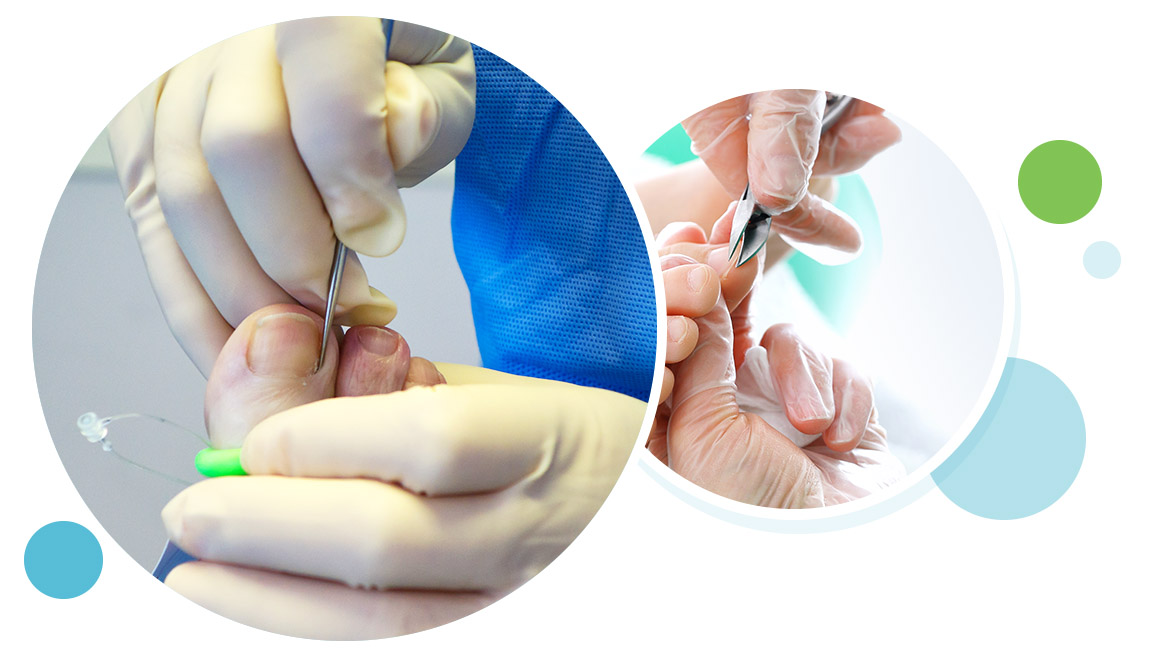Ingrown Toenails
Onychocryptosis, or ingrown toenails as they are referred to in the medical community are the most common foot condition, with more than three million cases being diagnosed in the United States every year. The causes that lead to this painful condition are wide-ranging. While some ingrown toenails can be taken care of with self-care, many require medical attention, especially if you are experiencing severe pain or if the toe is showing signs of infection. Individuals with chronic health problems such as circulatory issues or diabetes as well as children and women who are pregnant are at a greater risk for ingrown toenails.
What Are Ingrown Toenails?
Ingrown toenails result when the side or corner of the nail grows improperly and becomes embedded in the soft skin of the toe. This most frequently affects the medial or lateral border of the nail on the big toe. More significant issues may occur when an open wound is present, resulting in inflammation and potentially an abscess that may not heal and can lead to a granuloma. These are the three stages of an ingrown toenail and by considering this and the initial cause your podiatrist will be able to recommend the most effective treatment recommendation and help avoid recurrence.
Stages of Ingrown Toenails:
- Inflammatory Stage – You may notice redness and swelling occurring accompanied by moderate discomfort at the side of the nail plate.
- Abscess Stage – The tenderness and discomfort increases dramatically at this stage and pus may begin to drain from the infected area.
- Granulation – As the tissue hardens over the infected area drainage does not occur freely, often times requiring surgical treatment.
Leading Causes:
- The way you walk
- Poorly fitting shoes
- Foot Injury
- Genetic Factors (toe size, toenail size, deformities of the nail plate)
- Obesity
- Diabetes
- Improperly cut toenails
Symptoms of an Ingrown Toenail
If you are suffering from an ingrown toenail, you could have a variety of symptoms. Some of these symptoms are worse than others. Here are a few of the more common symptoms that accompany ingrown toenails:
- Redness of the area surrounding the toenail.
- Tenderness in the toe on one or both sides of the toenail.
- Pain in the toe and on the sides surrounding the toenail.
- Swelling of the toe, particularly around the toenail.
If you notice these symptoms, you should have your ingrown toenail checked by a your podiatrist specializing in treatment. If left untreated, these symptoms can lead to worse issues, such as an infection. In the more extreme cases the underlying bone can become infected. These complications can be more severe if you have diabetes, which can damage nerves in your feet and cause poor circulation of blood, which in more extreme cases could result in gangrene, a serious infection resulting from blood flow being interrupted.
Diagnosing An Ingrown Toenail
Usually, you can diagnose your own ingrown toenail by just looking at it. You will be able to see the corner of the nail embedded into the corner of the soft skin of the big toe. You may also see the redness and swelling around the nail. You should schedule an appointment with a physician before the problem worsens, and to make sure it is corrected before infection becomes an issue.
Treatment For Ingrown Toenails
Non-Surgical Ingrown Toenail Home Treatments
Most ingrown toenails should be treated aggressively. If you notice discomfort or infection you should see a podiatrist prior to any self-treatment. However, when caught in the very early stages you may be able help limit your risk of a worsening condition with the following conservative treatments.
Footwear
In order to reduce inflammation and for your own comfort you can wear sandals or go barefoot as much as possible for a few days. This will keep pressure off the ingrown nail. You should wear better fitting shoes, which will also help alleviate the problem.
Nail Care
Properly groom your toes. Don’t trim the corner of the toenail unless it is easily seen and accessed. If you pull the nail out without cutting the nail, a spicule is often times left causing problems. Cutting the nail too short also can cause the skin to envelope the nail.
Soaking
Soaking the affected area in warm soapy water or Epsom salt can help avoid further infection. This can be done multiple times daily.
Non-Surgical Podiatric Treatments
Medications
Your podiatrist might prescribe an oral antibiotic to reduce swelling and infection.
Anti-Fungal
There are instances when an ingrown toenail is caused by fungus. In that case, an anti-fungal medication will be prescribed to attack the infection.
Surgical Treatments
In more severe cases a podiatrist will recommend a surgical treatment. These often result in the lowest rates of recurrence but may have a longer recovery time.
Avulsion Procedure
In most circumstances a complete removal of the affected nail may be required. This may be the case if the cause is a disease rather than an actual ingrown toenail. The toenail will grow back but may be more susceptible to ingrown toenails.
Phenolization
The procedure combines a removal of the nail with a phenol ablation of the affected area. This means that the nail will not grow back in the area that is experiencing the ingrown toenail.
Ingrown Toenail Recovery
The recovery process for an ingrown toenail is usually smooth and a full recovery is achieved in a few 2–4 weeks, although, most people notice no limit in activity within the 24–48 hours.
Resources
Acfas.org (American College of Foot and Ankle Surgeons)
Surgical Treatment of Ingrown Toenails (Wikipedia)
Ingrown Toenails (Mayo Clinic)

